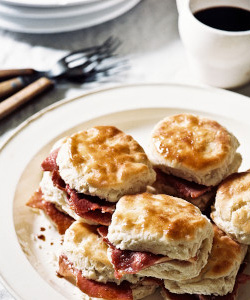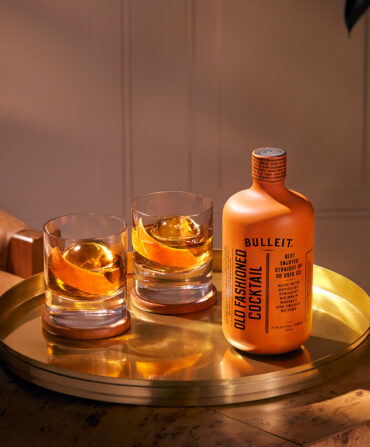You may have seen the description on a cocktail menu near you: Fat-washed. Not the most appealing appellation for a drink you’re thinking of sipping. But like all things related to butter, lard, and that fine edge of a perfectly seared sirloin, well—a fat-washed spirit is pretty damn delicious.

To fat-wash a bourbon or rye (or even a white rum) means to leave it intermingling with rendered, liquid fat, at a set ratio, for a set amount of time. This results, after straining, in a creamier spirit, possibly with a smoky finish, or one carrying a beautiful, oily, savory undercurrent. Fat-washing a feisty whiskey, for example, will subdue the burn and add a tongue-coating, velvety texture. It can spark the essence of bacon, or even of coconut (yes, spirits can be washed with plant fats, too).
“Think of fat-washing like you think of a vinaigrette—oil and water don’t mix,” explains Nick Farrell, the spirits director at the new Brewery Saint X taproom and bar, adjacent to Devil Moon Barbecue, in New Orleans. “But oil and alcohol do. That’s the molecular science behind it. Alcohol can bind with fat and pick up a flavor, unlike water. When you infuse alcohol with a liquid fat, the alcohol acts as a solvent. You get that richness and texture that a liquid fat has.”
Farrell shows off the technique in Brewery Saint X’s brisket old-fashioned. For that cocktail, Benchmark bourbon gets fat-washed with the kitchen’s leftover brisket renderings, then combined with cherry bitters and Amaro Sfumato. The finished drink is garnished with a pickle dropped in the glass, and, as the large cube of ice melts down, the vinegar starts to play in, changing the drink.
The fat-washing method traces its roots back to 2007, when the modern craft cocktail movement was just gaining steam. It was then that Don Lee, the opening bartender at an East Village bar called PDT (Please Don’t Tell), put a Benton’s old-fashioned on the menu, using maple syrup and whiskey infused with the flavor of hickory-smoked Benton’s bacon from Tennessee.
The straightforward method can even be executed at home. Farrell explains how: “Grab your bottle of whiskey. Reserve some rendered fat, like your bacon grease. You want to make sure that the fat is warm enough to be a liquid, but not hot. Don’t go pouring your boiling bacon grease into your whiskey. That’s not going to be good for anyone,” he says with a laugh. “You want to start with a ten-to-one ratio. That’s one part fat to ten parts alcohol. Then, you are going to use a non-reactive container. A mason jar works great.”
As for that grease you have from your morning pan, no need to be precious about it. “Don’t strain your bacon fat,” Farrell advises. “Let those little charred flecks go on in. Then, shake the mixture up and let it sit overnight, shaking it once or twice more during that time span. After that, toss it in freezer. The fat cap will form, which is why a mason jar works best. In a fresh container, set up a strainer lined with a coffee filter. Poke a hole in the fat cap and pour the fat-washed spirit through the strainers. You have your fat-washed spirit. It’s that simple.”
Once you’ve tried it, you can then experiment with different spirits and different fats and altered ratios. “With mellower flavors, like coconut fat, you can go stronger—maybe eight-to-one,” Farrell says. “At a certain point, you will reach a diminishing return. There is only so much flavor the booze can pick up from the fat. For aged spirits, pork fat and duck fat work great. Plant fats go better with white spirits, and you can also look at nut fats, too.”
Or, just go seek out a barstool. At Apothecary in Dallas you can sip a Pekin Tom, a duck confit–washed bourbon, with lapsang tea-infused peach liqueur, absinthe, and peach smoke. Market, in Tampa’s Edition hotel, offers the cheeky Peppergroni, a negroni made with pepperoni-infused gin.
Jeremy Buck also plays with fat-washing frequently. The bartender has dreamed up a peanut butter–washed old-fashioned in the past, as well as a truffle oil–washed daiquiri, during his time working in the likes of Mumbai and New York City. This fall, at Coterie—his modern Indian concept in Charleston, South Carolina—he’s eyeing a rack of ribs and French spirits. “We have a new tandoori rib dish, and I’m going to use the fat,” he says. “Smoked over applewood and braised for a long time, the rib fat will have those Indian spices. I’ll probably reach for a brandy. In brandy, especially when you are using cognac, you get those apple notes of autumn.”








